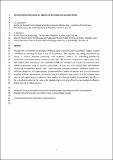Files in this item
Monitoring the biodiversity of regions : key principles and possible pitfalls
Item metadata
| dc.contributor.author | Buckland, S. T. | |
| dc.contributor.author | Johnston, Alison | |
| dc.date.accessioned | 2019-08-03T23:41:03Z | |
| dc.date.available | 2019-08-03T23:41:03Z | |
| dc.date.issued | 2017-10 | |
| dc.identifier | 250594810 | |
| dc.identifier | 6ff8680e-6b8b-4335-aa60-b8f87d6984c0 | |
| dc.identifier | 85026788185 | |
| dc.identifier | 000412788100004 | |
| dc.identifier.citation | Buckland , S T & Johnston , A 2017 , ' Monitoring the biodiversity of regions : key principles and possible pitfalls ' , Biological Conservation , vol. 214 , pp. 23-34 . https://doi.org/10.1016/j.biocon.2017.07.034 | en |
| dc.identifier.issn | 0006-3207 | |
| dc.identifier.other | ORCID: /0000-0002-9939-709X/work/73701041 | |
| dc.identifier.other | ORCID: /0000-0001-8221-013X/work/103865987 | |
| dc.identifier.uri | https://hdl.handle.net/10023/18240 | |
| dc.description | This work is based partly on Defra-funded research project BE0102 and available on the Defra Science website. | en |
| dc.description.abstract | Through the Convention on Biological Diversity (CBD) 2010 and 2020 biodiversity targets, nations committed to reducing the rate of loss of biodiversity. This requires calculating the biodiversity trends in nations, whereas previously, most academic research on quantifying biodiversity concerned communities within relatively small sites. We consider design and analysis issues that CBD targets raise and explore the potential pitfalls for managers of monitoring schemes when statistical principles yield to practical constraints. We list five main criteria that well-designed monitoring programmes should meet: representative sampling locations, sufficient sample size, sufficient detections of target species, a representative sample of species, and a sound temporal sampling scheme. We examine the implications of biodiversity assessments that fail to meet these criteria and suggest ways to alleviate these implications through analytical approaches. We discuss the remarkable potential for wide-scale biodiversity monitoring offered by technological advances and by the rise of citizen science. | |
| dc.format.extent | 12 | |
| dc.format.extent | 1008747 | |
| dc.language.iso | eng | |
| dc.relation.ispartof | Biological Conservation | en |
| dc.subject | Animal abundance estimation | en |
| dc.subject | Biased sample | en |
| dc.subject | Biodiversity trends | en |
| dc.subject | Convention for Biological Diversity targets | en |
| dc.subject | Geometric mean | en |
| dc.subject | Representative sample | en |
| dc.subject | GE Environmental Sciences | en |
| dc.subject | QH301 Biology | en |
| dc.subject | T-NDAS | en |
| dc.subject.lcc | GE | en |
| dc.subject.lcc | QH301 | en |
| dc.title | Monitoring the biodiversity of regions : key principles and possible pitfalls | en |
| dc.type | Journal article | en |
| dc.contributor.institution | University of St Andrews. School of Mathematics and Statistics | en |
| dc.contributor.institution | University of St Andrews. Marine Alliance for Science & Technology Scotland | en |
| dc.contributor.institution | University of St Andrews. Scottish Oceans Institute | en |
| dc.contributor.institution | University of St Andrews. St Andrews Sustainability Institute | en |
| dc.contributor.institution | University of St Andrews. Centre for Research into Ecological & Environmental Modelling | en |
| dc.contributor.institution | University of St Andrews. Statistics | en |
| dc.identifier.doi | https://doi.org/10.1016/j.biocon.2017.07.034 | |
| dc.description.status | Peer reviewed | en |
| dc.date.embargoedUntil | 2019-08-04 |
This item appears in the following Collection(s)
Items in the St Andrews Research Repository are protected by copyright, with all rights reserved, unless otherwise indicated.

